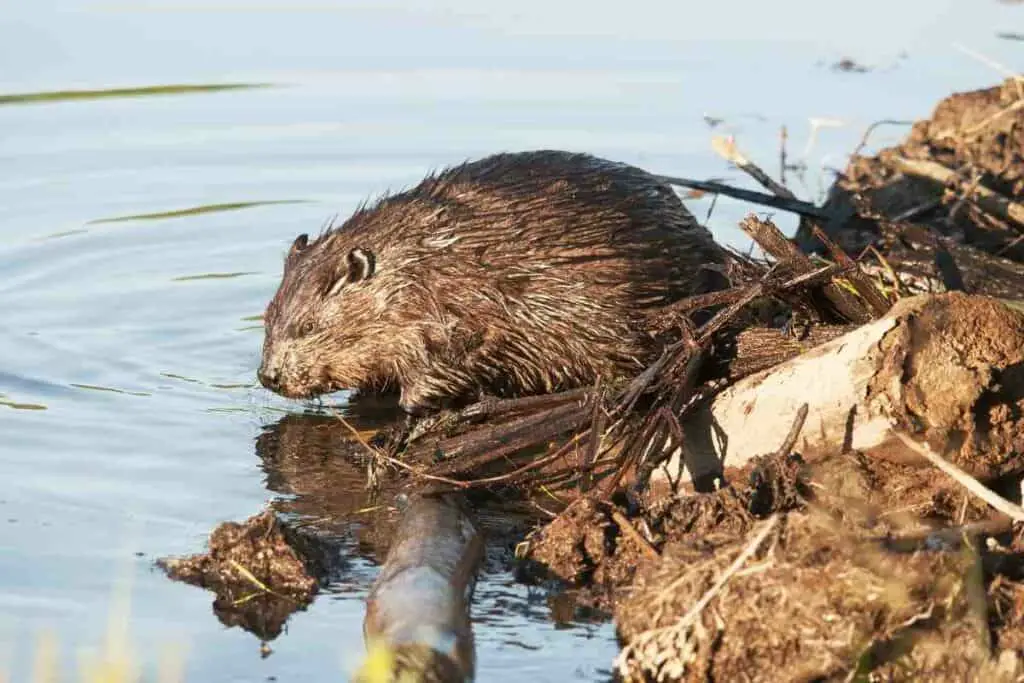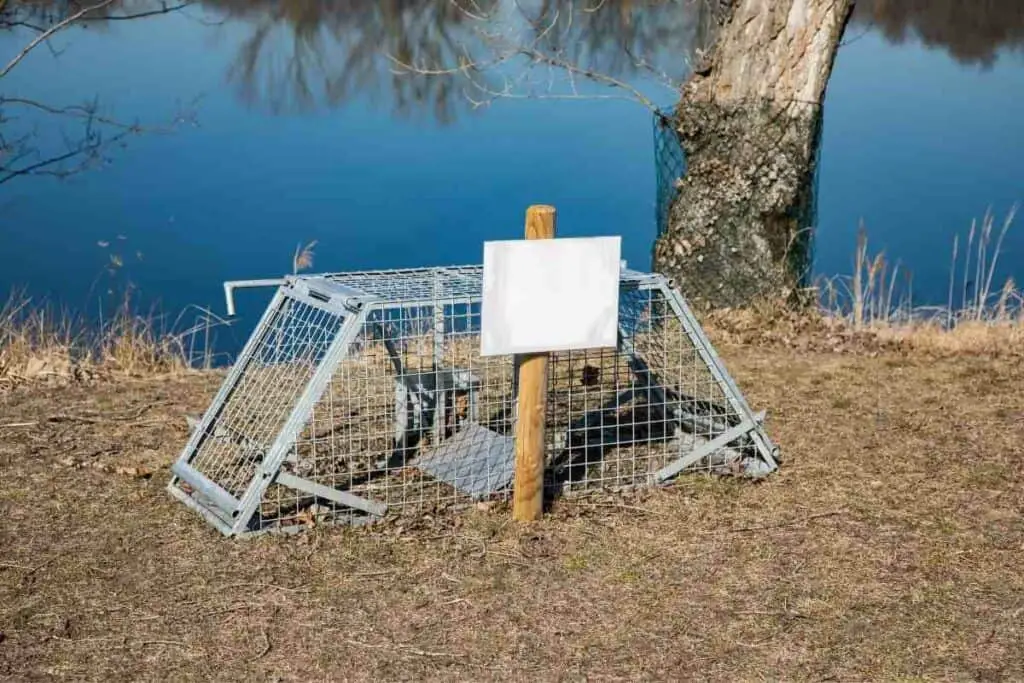Beavers will easily deforest an area and block waterways when building their dams.
The best method to get rid of beavers is using control measures, for example, trapping, fencing, draining their dams, and destroying the lodges more than killing.
If you kill the beavers, the chances are that other beavers will move in sooner or later. Before getting rid of them, you should have noted their presence in your area.
You should recognize most of their everyday activities such as building beaver lodges, slides, pathways, cutting down trees, floods, and construction of beaver dams.
Another means of identifying their presence is through observation.
If you come across a mammal with prominent buck teeth, a large tail, weighs about 60 pounds, and is about 3 to 4 feet long, then you probably have a beaver living in your compound.

Beavers might invade your land for shelter, safety, or in search of food. They are attracted to small streams, silent rivers, trees and bushes, and muddy terrains.
Table of Contents
What Are The Common Methods Used To Get Rid Of Beavers?
Beavers build dams that interfere with the normal flow of water, thus flooding the area. They are also responsible for the destruction of trees and valuable vegetation.
They might also pass diseases to you or your domestic animals. Beavers carry diseases such as rabies, liver failure, and even parasites that are of great danger to other living creatures.
However, it is essential to note that beaver dams can benefit the ecosystem. For starters, they create wetlands that support different animals and plants. They also prevent flooding and reduce the likelihood of toxins and sediment from filtering into streams.
NOTE
Please do not interfere with them unless you are dealing with beavers on private property or have thoroughly done a cost-benefit analysis.
Use of beaver traps

Traps are the most efficient method of controlling beavers on your farm. The most common type of beaver trap is the Conibear trap.
Conibear traps are dipped in the water near the drainage or at the channel entrance of the beaver’s habitat. In some states, it is only legal to use beaver traps at certain times of the year unless you have a permit to do so.
The use of lethal snap traps, like the ones used to kill rodents, tend to put other wild lives in danger since they can also get tricked by the trap and end up killing the unintended creature.
For the lethal snap traps to work efficiently, you have to place them in the most suitable location, which is usually the major walkway of the beaver and where other animals find it difficult to pass through.
The best way to trick the beaver into the trap is by luring it with the scent of another beaver. The scent is one of their primary means of communicating.
However, hiring a professional is way cheaper and faster than doing it yourself unless you are well-skilled and already experienced in doing the job.
Beavers are very good at avoiding traps, but the job seems easy and fast when done by a professional.
Factors to consider when choosing a beaver traps
- So as not to harm the beaver, the trap’s interior should have smooth edges to avoid injuring the animal.
- The size of the trap should be sufficient for the beaver to fit in. The trap should be at least 45 inches long and 15 inches wide to ensure both the body and the tail fit comfortably.
- The trap should be strong enough to ensure it can stand the harsh environment and the beaver does not flee away.
How to trap beavers
- Place the trap in the evening before beavers get out searching for food.
- Set the trap opening facing the beavers’ den.
- After placing the trap, regularly check to ensure the beaver does not get dehydrated or hungry if captured already.
- Disengage an empty trap in the morning to avoid trapping unwanted animals.
- Wear heavy gloves to avoid bites.
- Relocate the beaver to another aqua environment at least 15 miles from your home environment.
- After ensuring there are no beavers left, rebuild their habitat to make it unsuitable for the beavers to live in. This is quite challenging as it is difficult to manipulate the beaver’s environment.
- Pull apart the lodges and the dam and remove any building material the beavers might use to reconstruct their home.
Use of a fence around the farm and trees
Fence small parts of the farm with a woven wire mesh or an electric fence. You should bury the wire mesh about 10cm deep and at least 90cm high.
One can fence trees and other large plants individually by wrapping them with wire mesh.
Use of homemade repellents
This method applies best to small-scale landowners but is impractical to large-scale owners. Textural repellents, such as paint mixed with sand, work better than other repellents such as ammonia, garlic, predator urine, hair, and mothballs.
You will have to reapply the repellent several times, though it is not guaranteed to work. This method doesn’t work well with very hungry beavers as they tend to ignore the repellent in search of food.
Also, if you live in a rainy or moist environment, this method should be the last option since it’s not as successful as it sounds.
Items needed to make homemade repellents?
- 1 gallon of water
- Coarse sand creates a gritty texture in their mouth once they chew the plant.
- Can of latex paint to allow the bark to breathe and a painting brush to apply the latex paint.
- A mixing stick to mix the mixture.
Process of making homemade repellents
- Mix the coarse sand with the latex paint and one gallon of water in a bucket.
- Mix the mixture thoroughly with the mixing stick until they blend in well with the sand and the paint.
- Paint the trees around four to five feet up using the painting brush and allow the mixture to dry for about 24 hours.
- Apply the mixture once it gets thin due to the sun and the moisture outside.
You could use a sound repellent like this!
Killing the beavers
Sometimes the beavers can be annoying, and one can be forced to kill them instead of trapping and releasing them. If you have decided to kill the beaver, you should consider using the best humane methods possible since, in some states, it is illegal to kill them in some unhuman way.
Also, you are only allowed to kill beavers on private land.
The most common way people kill beavers is by shooting them. While you need a license to shoot beavers, it is safer than using poison.
You should contact the beaver control conservation office first to understand the laws regarding the killing of beavers. In most cases, the environmental agents prefer to relocate the beavers to a different environment instead of killing them.
In some states, it’s not illegal, and you can kill the beaver as long as you use the safest means possible
Why You Should Never Poison Beavers
It is very illegal to use poison to kill beavers in some states, while in some states, it’s not. They consider it dangerous because it can result in the death of other creatures rather than killing the beavers.
The poison can accidentally infect streams and rivers, killing aqua life. Humans can also be affected as some rely on rivers and streams as a water source.
Beavers don’t immediately take the food they have gathered but instead store it for later use. Most beavers use underground lairs to store food when the temperatures are pretty low.
The underground lairs are mostly connected with water bodies through channels or aquatic plants such as weeds and reeds.
This can lead to contamination of the water bodies, accidentally killing other animals or poisoning humans.
Final Thoughts.
Beavers are huge rodents that live in areas with a good water source, such as springs or swamps. They can be annoying sometimes to an extent where you are forced to get rid of them.
Their destructive nature can greatly lose to your farm and animals such as pets and livestock.
Getting rid of them is not that easy due to their adaptability and persistence.
Control and preventive measures are more advised than elimination means since killing them will only create room for other beavers to inhibit unless you destroy their habitat and make it unfavorable for them to live in.




